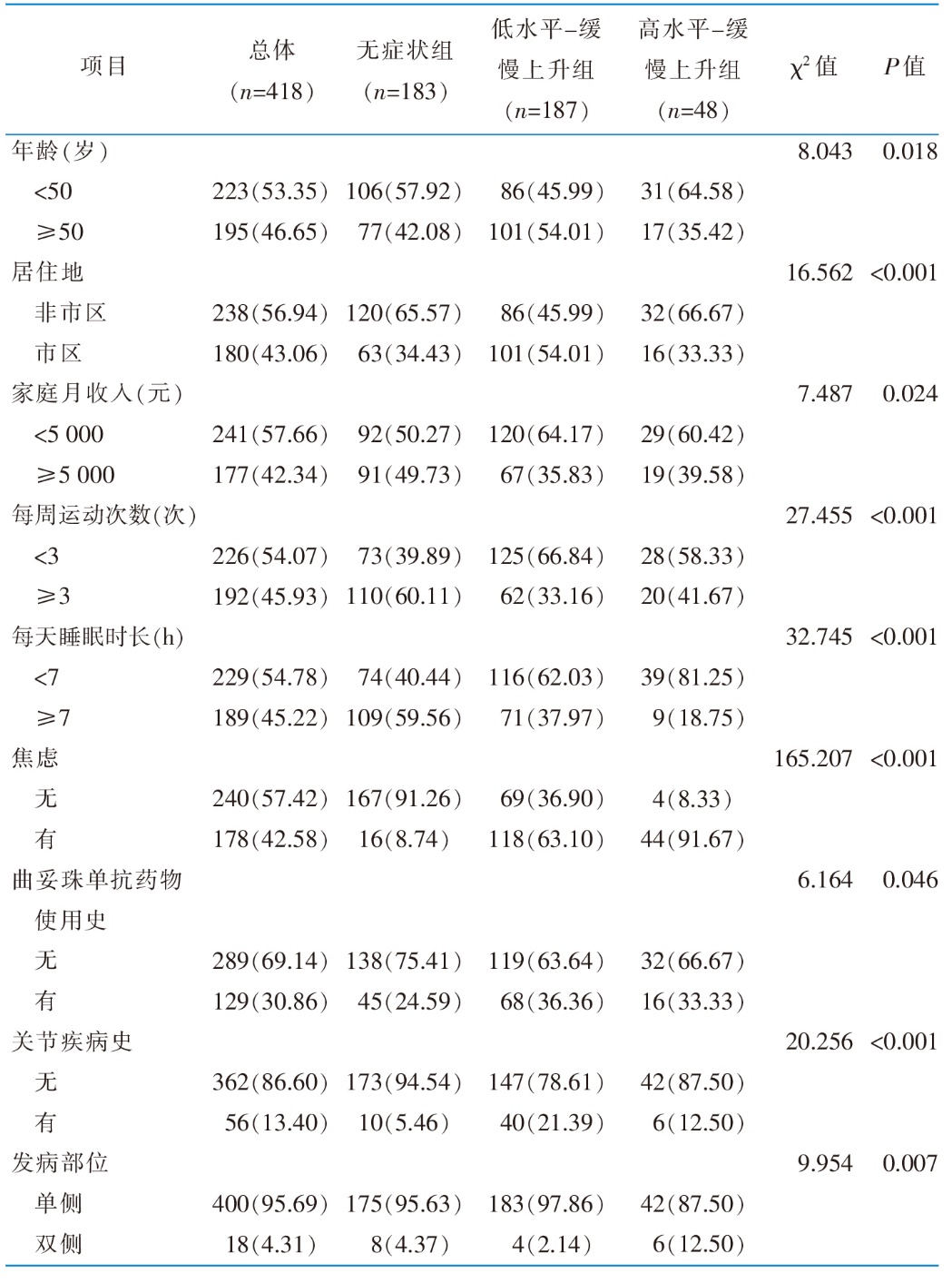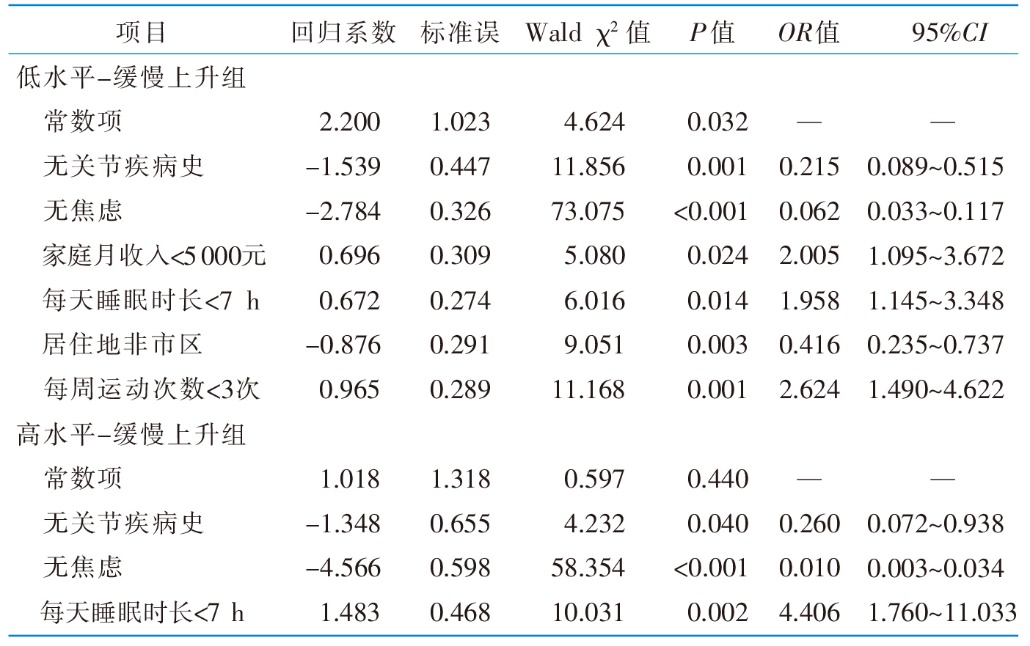


中华护理杂志 ›› 2024, Vol. 59 ›› Issue (14): 1732-1738.DOI: 10.3761/j.issn.0254-1769.2024.14.010
王莉杰( ), 彭思意, 陈婕君, 魏涛, 刘佳惠, 胡美红, 李旭英(
), 彭思意, 陈婕君, 魏涛, 刘佳惠, 胡美红, 李旭英( )
)
收稿日期:2023-07-11
出版日期:2024-07-20
发布日期:2024-07-11
通讯作者:
李旭英,E-mail:1259734926@qq.com作者简介:王莉杰:女,本科(硕士在读),护士,E-mail:1679343421@qq.com
基金资助:
WANG Lijie( ), PENG Siyi, CHEN Jiejun, WEI Tao, LIU Jiahui, HU Meihong, LI Xuying(
), PENG Siyi, CHEN Jiejun, WEI Tao, LIU Jiahui, HU Meihong, LI Xuying( )
)
Received:2023-07-11
Online:2024-07-20
Published:2024-07-11
摘要:
目的 探讨乳腺癌患者内分泌治疗相关骨关节疼痛发展轨迹的潜在类别及影响因素,为实施针对性的健康教育提供依据。方法 采用便利抽样法,选取2022年1月—7月在湖南省某三级甲等肿瘤专科医院乳腺内科住院或门诊就诊的乳腺癌患者481例作为调查对象。采用一般资料调查表、乳腺癌内分泌治疗患者症状评估量表、焦虑自评量表在患者治疗前1周内进行基线调查,采用乳腺癌内分泌治疗患者症状评估量表在患者治疗后3、6、9个月调查患者骨关节疼痛水平,采用增长混合模型、单因素分析和多元Logistic回归分析数据。结果 共418例(86.90%)乳腺癌患者完成随访,发生骨关节疼痛235例(56.22%)。识别出骨关节疼痛发展轨迹的3个潜在类别,分别为高水平-缓慢上升组(11.48%)、低水平-缓慢上升组(44.74%)、无症状组(43.78%)。多元Logistic回归分析结果显示,焦虑、关节疾病史、每天睡眠时长、居住地、家庭月收入、每周运动次数是乳腺癌患者内分泌治疗相关骨关节疼痛水平发展轨迹潜在类别的影响因素(P<0.05)。结论 乳腺癌患者内分泌治疗相关骨关节疼痛水平呈现不同的变化轨迹,临床医护人员应重视存在焦虑、关节疾病史、睡眠时间短、家庭经济状况差、居住在市区及每周运动次数少的患者疼痛水平的评估和干预。
王莉杰, 彭思意, 陈婕君, 魏涛, 刘佳惠, 胡美红, 李旭英. 乳腺癌患者内分泌治疗相关骨关节疼痛发展轨迹及护理启示[J]. 中华护理杂志, 2024, 59(14): 1732-1738.
WANG Lijie, PENG Siyi, CHEN Jiejun, WEI Tao, LIU Jiahui, HU Meihong, LI Xuying. Analysis of the development trajectory and influencing factors of endocrine therapy associated arthralgia in breast cancer patients[J]. Chinese Journal of Nursing, 2024, 59(14): 1732-1738.
 |
表1 乳腺癌患者的一般资料及骨关节痛发展轨迹潜在类别的单因素分析结果 [例(百分比,%)]
Table 1 Demographic characters and univariate analysis of potential categories of trajectory of arthralgia development in breast cancer patients[cases(percentage,%)]
 |
 |
表3 乳腺癌患者骨关节痛发展轨迹潜在类别的多元Logistic回归分析结果(n=418)
Table 3 Results of multiple logistic regression of arthralgia dependency trajectories category in breast cancer patients(n=418)
 |
| [1] | Sung H, Ferlay J, Siegel RL, et al. Global cancer statistics 2020:GLOBOCAN estimates of incidence and mortality worldwide for 36 cancers in 185 countries[J]. CA Cancer J Clin, 2021, 71(3):209-249. |
| [2] | van Hellemond I, Geurts S, Tjan-Heijnen V. Current status of extended adjuvant endocrine therapy in early stage breast cancer[J]. Curr Treat Options Oncol, 2018, 19(5):26. |
| [3] | Chan C, Tai D, Kwong S, et al. The effects of pharmacological and non-pharmacological interventions on symptom management and quality of life among breast cancer survivors undergoing adjuvant endocrine therapy:a systematic review[J]. Int J Environ Res Public Health, 2020, 17(8):2950. |
| [4] | Yao LT, Wang MZ, Wang MS, et al. Neoadjuvant endocrine therapy:a potential strategy for ER-positive breast cancer[J]. World J Clin Cases, 2019, 7(15):1937-1953. |
| [5] | Pineda-Moncusí M, Servitja S, Tusquets I, et al. Assessment of early therapy discontinuation and health-related quality of life in breast cancer patients treated with aromatase inhibitors:B-ABLE cohort study[J]. Breast Cancer Res Treat, 2019, 177(1):53-60. |
| [6] |
Curigliano G, Burstein HJ, Winer EP, et al. De-escalating and escalating treatments for early-stage breast cancer:the St.Gallen international expert consensus conference on the primary therapy of early breast cancer 2017[J]. Ann Oncol, 2017, 28(8):1700-1712.
DOI PMID |
| [7] |
Beckwée D, Leysen L, Meuwis K, et al. Prevalence of aromatase inhibitor-induced arthralgia in breast cancer:a systematic review and meta-analysis[J]. Support Care Cancer, 2017, 25(5):1673-1686.
DOI PMID |
| [8] | Brier MJ, Chambless DL, Chen J, et al. Ageing perceptions and non-adherence to aromatase inhibitors among breast cancer survivors[J]. Eur J Cancer, 2018,91:145-152. |
| [9] | Yanez B, Gray RJ, Sparano JA, et al. Association of modifiable risk factors with early discontinuation of adjuvant endocrine therapy:a post hoc analysis of a randomized clinical trial[J]. JAMA Oncol, 2021, 7(8):1-7. |
| [10] | Lintermans A, Van Asten K, Wildiers H, et al. A prospective assessment of musculoskeletal toxicity and loss of grip strength in breast cancer patients receiving adjuvant aromatase inhibitors and tamoxifen,and relation with BMI[J]. Breast Cancer Res Treat, 2014, 146(1):109-116. |
| [11] | 陈世耀, 刘晓清. 医学科研方法[M]. 北京: 人民卫生出版社,2015:116-117. |
| Chen SY, Liu XQ. Medical scientific research methods[M]. Bei-jing: People’s Medical Publishing House,2015:116-117. | |
| [12] |
李晴晴, 倪建芬, 方群英, 等. 乳腺癌内分泌治疗患者症状评估量表的编制和信效度检验[J]. 中华护理杂志, 2021, 56(6):880-886.
DOI URL |
|
Li QQ, Ni JF, Fang QY, et al. Construction and preliminary application of a Symptom Assessment Scale for Breast Cancer Patients with Endocrine Therapy[J]. Chin J Nurs, 2021, 56(6):880-886.
DOI URL |
|
| [13] | Zung WW. A rating Instrument for Anxiety Disorders[J]. Psycho-somatics, 1971, 12(6):371-379. |
| [14] |
Dunstan DA, Scott N, Todd AK. Screening for anxiety and depression: reassessing the utility of the Zung Scales[J]. BMC Psychiatry, 2017, 17(1):329.
DOI PMID |
| [15] | 田银娣, 王怡恺, 李静, 等. 焦虑和抑郁量表在肝硬化患者临床应用中的信效度评价[J]. 实用肝脏病杂志, 2019, 22(1):105-108. |
| Tian YD, Wang YK, Li J, et al. Evaluation of reliability and validity of Self-Rating Anxiety Scale and Self-Rating Depression Scale in patients with liver cirrhosis[J]. J Clin Hepatol, 2019, 22(1):105-108. | |
| [16] |
Shi Q, Giordano SH, Lu H, et al. Anastrozole-associated joint pain and other symptoms in patients with breast cancer[J]. J Pain, 2013, 14(3):290-296.
DOI PMID |
| [17] | Pan F, Tian J, Cicuttini F, et al. Metabolic syndrome and trajectory of knee pain in older adults[J]. Osteoarthritis Cartilage, 2020, 28(1):45-52. |
| [18] |
荆凤, 邢唯杰, 裘佳佳, 等. 乳腺癌患者内分泌治疗相关症状的调查研究[J]. 中华护理杂志, 2021, 56(5):737-743.
DOI URL |
|
Jing F, Xing WJ, Qiu JJ, et al. Symptoms and its influencing factors among breast cancer survivors undergoing adjuvant endocrine therapy[J]. Chin J Nurs, 2021, 56(5):737-743.
DOI URL |
|
| [19] |
Castel LD, Hartmann KE, Mayer IA, et al. Time course of arthralgia among women initiating aromatase inhibitor therapy and a postmenopausal comparison group in a prospective cohort[J]. Cancer, 2013, 119(13):2375-2382.
DOI PMID |
| [20] | Lopez C, Charles C, Rouby P, et al. Relations between arthralgia and fear of recurrence:results of a cross-sectional study of breast cancer patients treated with adjuvant aromatase inhibitors therapy[J]. Support Care Cancer, 2015, 23(12):3581-3588. |
| [21] | Laroche F, Coste J, Medkour T, et al. Classification of and risk factors for estrogen deprivation pain syndromes related to aromatase inhibitor treatments in women with breast cancer:a prospective multicenter cohort study[J]. J Pain, 2014, 15(3):293-303. |
| [22] | Husak AJ, Bair MJ. Chronic pain and sleep disturbances:a pragmatic review of their relationships,comorbidities,and treatments[J]. Pain Med, 2020, 21(6):1142-1152. |
| [23] | Duo L, Yu X, Hu R, et al. Sleep disorders in chronic pain and its neurochemical mechanisms:a narrative review[J]. Front Psychiatry, 2023,14:1157790. |
| [24] | Lu G, Zheng J, Zhang L. The effect of exercise on aromatase inhibitor-induced musculoskeletal symptoms in breast cancer survivors:a systematic review and meta-analysis[J]. Support Care Cancer, 2020, 28(4):1587-1596. |
| [25] |
荆凤, 王园园, 邢唯杰, 等. 乳腺癌患者芳香化酶抑制剂诱导的骨关节症状预防和管理的证据总结[J]. 中华护理杂志, 2023, 58(7):808-815.
DOI URL |
|
Jing F, Wang YY, Xing WJ, et al. Evidence summary of the prevention and management in breast cancer patients for aromatase inhibitors-induced musculoskeletal symptoms[J]. Chin J Nurs, 2023, 58(7):808-815.
DOI URL |
|
| [26] | Jones MD, Booth J, Taylor JL, et al. Aerobic training increases pain tolerance in healthy individuals[J]. Med Sci Sports Exerc, 2014, 46(8):1640-1647 |
| [27] |
Wang T, Huang YY, Liu XL, et al. Prevalence and correlates of joint pain among Chinese breast cancer survivors receiving aromatase inhibitor treatment[J]. Support Care Cancer, 2022, 30(11):9279-9288.
DOI PMID |
| [28] |
郭苗苗, 严婷婷, 许丹丹, 等. 乳腺癌患者全病程管理信息系统的开发与应用研究[J]. 中华护理杂志, 2024, 59(8):901-908.
DOI URL |
|
Guo MM, Yan TT, Xu DD, et al. Development and application of a whole course management information system for breast cancer[J]. Chin J Nurs, 2024, 59(8):901-908.
DOI URL |
| [1] | 韩冬芳, 田甜, 高畅, 张婧珺, 李小妹. 肺结核患者健康促进行为与健康心理控制源关系的混合研究[J]. 中华护理杂志, 2024, 59(9): 1029-1036. |
| [2] | 司茜茜, 王莹, 赵福云, 马晓骁, 刘均娥. A型主动脉夹层患者Ⅰ期心肺康复护理方案的构建及应用[J]. 中华护理杂志, 2024, 59(9): 1037-1042. |
| [3] | 沈支佳, 陈新宇, 钱志杰, 殷丽梅. 反复低血糖患者血糖管理行为退化特征的混合研究[J]. 中华护理杂志, 2024, 59(9): 1043-1050. |
| [4] | 王丽梅, 李露, 李玉霞, 喻鹏, 罗倩, 张翀旎. 糖尿病周围神经病理性疼痛患者运动恐惧现状及影响因素分析[J]. 中华护理杂志, 2024, 59(9): 1051-1056. |
| [5] | 丁慧敏, 戴莉敏, 蔡冬青, 杨群. 糖尿病前期患者自我管理潜在剖面分析及影响因素研究[J]. 中华护理杂志, 2024, 59(9): 1057-1064. |
| [6] | 刘海婷, 王咏梅, 郑贝贝, 蔡丽丽, 叶林斌, 吴佳芸, 宁丽, 李益民, 陈为霞. 冠心病合并糖尿病患者药物素养自评量表的编制及信效度检验[J]. 中华护理杂志, 2024, 59(9): 1065-1071. |
| [7] | 陈丽霞, 施慧, 朱德政, 曾莹. 成人低血糖恐惧评估工具的质量评价[J]. 中华护理杂志, 2024, 59(9): 1072-1079. |
| [8] | 中国研究型医院学会过敏医学专业委员会, 中华医学会变态反应分会过敏性疾病护理学组(筹), 中华预防医学会过敏病预防与控制专业委员会, (执笔:王青 刘君 支凡 万文锦 田丰英 霍晓鹏 周文华 杨永仕 王田田 孙劲旅). 变应原特异性免疫治疗皮下注射护理的专家共识[J]. 中华护理杂志, 2024, 59(9): 1080-1083. |
| [9] | 李琪, 苏晴晴, 张瑶瑶, 王田田, 吕静, 李亚可, 李海燕. 全膝关节置换患者关节遗忘变化轨迹及影响因素研究[J]. 中华护理杂志, 2024, 59(9): 1084-1090. |
| [10] | 刘娅, 刘晓晴, 杨雪凝, 王平, 刘学奎, 罗丹. 结肠镜检查患者肠道准备失败风险预测模型的构建及验证[J]. 中华护理杂志, 2024, 59(9): 1091-1098. |
| [11] | 孙晓晴, 张爱霞, 朱珠, 樊雪梅, 梅士娟, 黄欣欣, 丛胜楠, 谢红燕. 分娩心理创伤评估量表的编制及信效度检验[J]. 中华护理杂志, 2024, 59(9): 1099-1105. |
| [12] | 谢玉生, 黄蓉蓉, 赵雪, 马蕾, 胡雁, 杨倩, 王乾沙, 明玥. 成人重度烧伤患者肠内肠外营养的证据总结[J]. 中华护理杂志, 2024, 59(9): 1106-1113. |
| [13] | 李旭琴, 冯洁惠, 黄昉芳, 俞超, 梁诗雨, 王晓, 李旭芳, 朱含. 1例行机械循环辅助桥接心脏移植患者的术前护理[J]. 中华护理杂志, 2024, 59(9): 1114-1117. |
| [14] | 贾晓静, 陈一竹, 许志英, 和霞, 耿超. 1例尿黑酸尿症双膝关节置换术后患者并发急性心肌梗死的护理[J]. 中华护理杂志, 2024, 59(9): 1118-1121. |
| [15] | 顾培培, 曾妃, 兰美娟, 梁江淑渊, 郭璐瑶, 蔡凌云, 朱岩, 郭鸽. 肺移植患者衰弱影响因素的Meta分析[J]. 中华护理杂志, 2024, 59(9): 1122-1129. |
| 阅读次数 | ||||||
|
全文 |
|
|||||
|
摘要 |
|
|||||